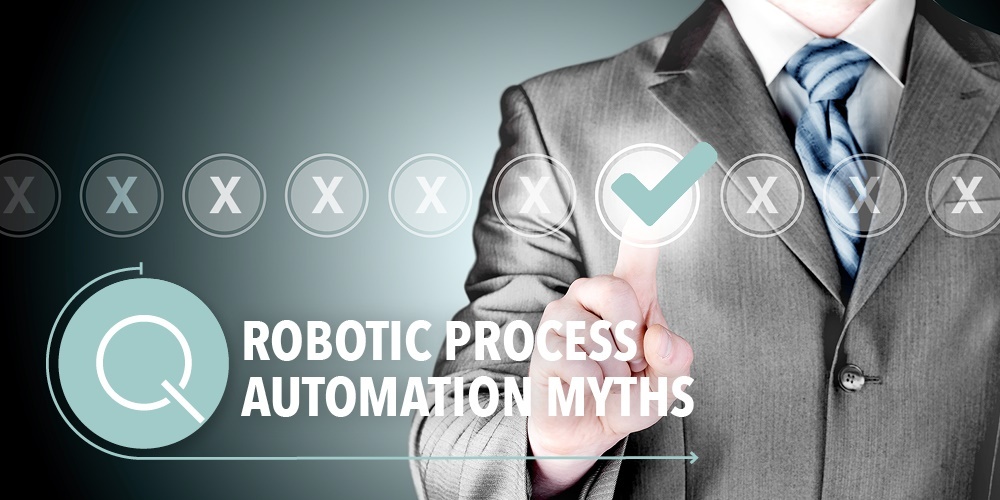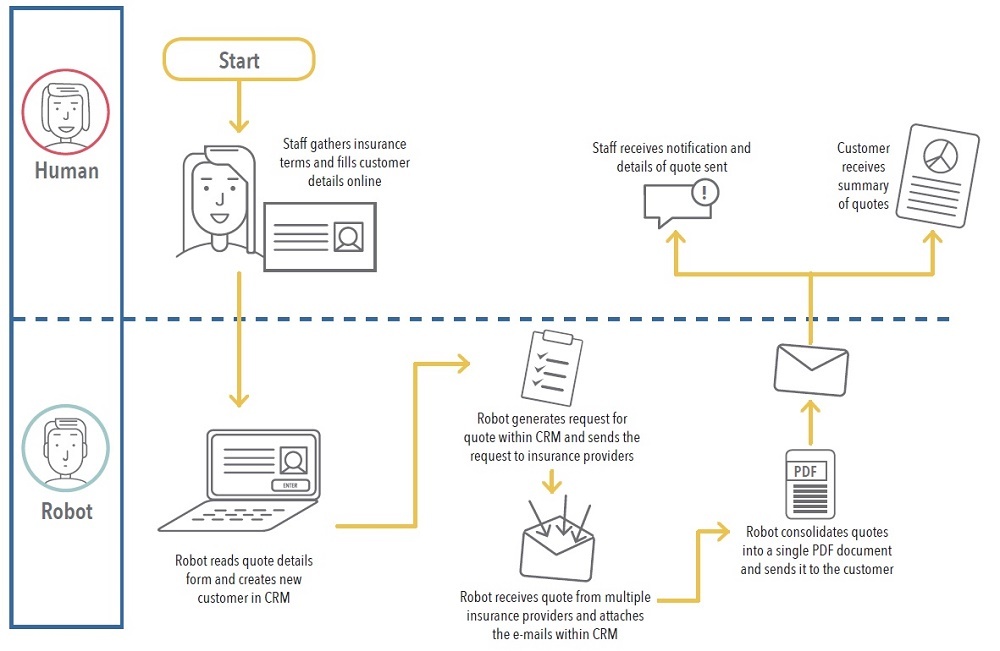
Last week we launched our new E Book, Robotic Process Automation: Preparation and Early Stage Planning. Based on lessons from early adopters and our experience implementing RPA in the New Zealand market, the guide covers topics such as benefit measurement, implementation risks and barriers to adoption and is designed to enable New Zealand businesses leaders to make strategic and informed decisions. Over the next eight weeks, we’ll be publishing snippets for you to glean lessons from early adopters and get vital knowledge to position your RPA programme for success or for all of the information in one place you can get your full copy of the guide.
In the past twelve months, we have seen an apparent shift in the market both regarding the level of interest in Robotic Process Automation (RPA) and the level of knowledge people have when we initially engage with them. Despite the increase in interest and knowledge, several myths maintain a strong presence.
Myth #1 Robotic Process Automation will create job losses.
A misconception from stakeholders and staff across a business is that there will be job losses with the introduction of RPA. Equally, it would be incorrect to assume the opposite, that RPA can solve a business problem by removing people from the business to reduce operating costs. Both globally and locally, this is proving not to be the case.
The fact is that 92-94% of end-to-end processes require human involvement and subsequently not all tasks can be 100% automated.
(Source unknown)

The human workforce is still very much needed for decision making, creativity, relationship management and other higher order tasks. In the words of Dawie Oliver (Westpac New Zealand CIO) “Robotic Process Automation is about removing the repetitious and mundane to allow humans to focus on those sweet points where being human is the “killer app”. There is no doubt that jobs will change because of digital technologies (including RPA) but businesses will not operate without people because of digital and automation technologies. The opportunity, therefore, is looking at how the two work forces are blended to work as a holistic workforce.
Focus on educating the business early on; be transparent, include your people and take teams on the journey. Use tools such as video demonstrations and create context around the technology.
Contributed by Sharyn Catt
Myth #2 Robotic Process Automation is a Silver Bullet.
In some instances, RPA has been promoted as a silver bullet which can fix all problems related to inefficiencies within an enterprise. Viewing RPA in this light creates the risk that the RPA programme will encounter pitfalls and likely fail to meet expectations within an organisation.
RPA is an integral part of transformation but needs to be looked upon as part of the broader digitisation strategy.

RPA should also be considered in conjunction with other technologies such as Business Process Management, Desktop Automation, Virtual Assistants, cognitive computing and Artificial Intelligence.
Most importantly defining success and seeing RPA as an end to end change program and not just as a series of automations, can lay the real foundation of RPA being a strategic solution.
Contributed by Shweta Garg
Myth #3 All Robotic Process Automation Technologies are the Same.
There is a misconception that all RPA technologies deliver the same functionality. As an emerging technology, many providers are offering products under the currently undefined category of Robotic Process Automation resulting in a wide range of technology offerings which are not alike in functionality and capability.
In a 2016 study, the London School of Economics found 39 tools promoting themselves as RPA and over 120 being sold with some form of cognitive automation.

In general terms, we can divide the current process automation technologies into two spheres: Enterprise Automation and Assisted Automation. A differentiating factor is: Enterprise Automation supports unattended end-to-end automation of back-office processes autonomously, i.e. does not need any input from the user. Assisted Automation addresses front-office processes with the aid/input of a human counterpart.
This fundamental difference has an impact on the type of processes which can be automated. One platform may not be suitable for application to processes within your organisation, and the inherent risk is the adoption of a platform that is not suited to business requirements.
Contributed by Mel Vissor
Myth #4 Robotic Process Automation is a Low-Cost Solution.
Robotic Process Automation (RPA) is an investment. Possibly from lack of knowledge or through misperceptions created by the pricing and acquisition strategies of some providers, there is an idea in the market that RPA is cheap.

In comparison to traditional technology, there would be an argument to support that RPA is a more cost-effective alternative. However, important to note that the cost of the actual software is a minor portion of the overall investment. Most of the cost will be incurred through consultancy and professional services to get RPA implemented for success. Research and experience also suggest that organisations will need to partner to achieve success.
Where automation is positioned relative to an organisations business strategy will determine the level of investment required. Taking a long-term more strategic approach will initially have a higher investment profile – which should be considered in conjunction with the cumulative benefits and return on investment, which in the case of RPA far exceeds anything we have seen before.
Contributed by Sam Osborne
Myth #5 All Processes can be Automated.
Most of the clients we interact with have an impression that any existing process currently being completed manually could be automated. This perception can’t be farther away from the truth.
Not all processes are suitable for automation.

Even a process that is suitable for automation may not deliver a return on investment to an organisation if automated, based on the potential benefit that can be derived and the resources required to automate and manage the process.
Addressing the first aspect specific characteristics make processes suitable for automation, for example, the presence of structured data, compliance requirements or well-defined business rules. Not every task is ideal for automation, and even for the processes that are, it is rare that an entire process can be entirely automated.
To provide an example a process may take 15-30 minutes but only be executed once per month, the critical factor being that the process is occurring once per month. Depending on the organisation’s strategic drivers, this process may not result in benefit to the business or a significant return on investment relative to the effort required to automate the process in the initial instance as well as maintaining and controlling the process on an ongoing basis.
The other part of this myth is people think that a process that takes data from various sources could be automated. While a process seems like the perfect candidate for automation, the challenge is in identifying processes that deal with structured data as opposed to sources like scanned pdf files.
Equally, RPA only works with digital inputs. Instances, where manual inputs are required, will interrupt the ability to automate processes.
Contributed by Sanjay Ram

In summary, these are the five myths which we believe we encounter most commonly in organisations, but by no means are these myths considered exhaustive.
The suggestion is to begin by seeking to understand what perceptions exist within your organisation before determining how to dispel those myths.
Addressing the perceptions of RPA from people within your organisation will likely form one of the early challenges, and There is no silver bullet or an effortless way to do this.
Ultimately, debunking myths is one aspect of change management, and the messages remain the same. Be transparent with your people. Engage your teams and take the organisation on a journey.



